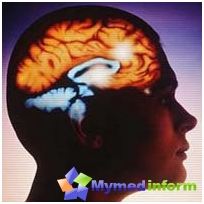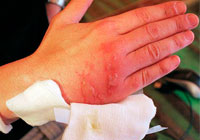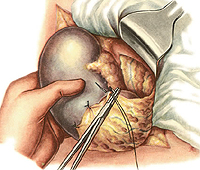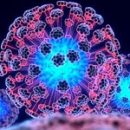The brain abscess is a complication of purulent-inflammatory processes in the body and clinically manifested by the symptoms of a common infectious disease, an increased intracranial pressure and focal neurological symptoms.
Content
Concept of brain abscess
The brain abscess usually arises as a complication of purulent inflammatory processes in the body, for example, purulent inflammation of the ear, apparent sinuses, lungs, bones, leather and subcutaneous fiber. Sometimes an abscess develops after an open brain injury, less often - after closed, in patients with ulcerative endocarditis.
The brain abscess is more likely to. However, multiple abscesses are found, usually metastatic.
In the initial stage of the disease, there is a picture of focal purulent encephalitis or a one-lawyoenette, which in some patients is exposed to reverse development. If the focal encephalitis takes a protracted flow, then the melting of the brain tissue comes and abscess is formed. Then the capsule is formed around it for 1-1.5 months, and abscess is isolated from the brain surrounding.
Basic symptoms of brain abscess
 Clinical signs can often be combined into three groups: symptoms of a general infectious disease, increased intracranial pressure and focal neurological symptoms.
Clinical signs can often be combined into three groups: symptoms of a general infectious disease, increased intracranial pressure and focal neurological symptoms.
Already in the initial stage of the abscess, which usually lasts 1-2 weeks, necessarily appear or enhanced headaches. They are permanent, attacking, cutting, shooting or stitching, are felt in the whole head or in the field of the nape, temple, forehead, the pattern, corresponding to the localization of the abscess.
Patients complain of pain of different intensity - from non-veins to unbearable, painful, which are accompanied by a turbulent motor reaction. When tapping across the skull, the pain is often amplified in the place where the abscess closely arrives at the brain shells. Characterized by periodic sharp increase in headaches and gradual increases of signs of a common infectious disease: increasing body temperature, general ailment, weakness, lethargy, sometimes stunning, drowsiness. Bradycardia (pulse 50-40 per minute) is replaced by tachycardia even during the day at a constant elevated body temperature. Neutrophilic leukocytosis and soe are constantly increasing. The patient's condition becomes heavy.
Due to increasing intracranial pressure, headaches are enhanced with cough, sneezing, outraging, some head movements. Sometimes the position of the head in patients, especially in patients with abscesses of the cerebellum, forced. Headaches are combined with nausea or vomiting, dizziness. More than half of the patients on the eye can be found congestive nipples of optic nerves. Features of the symptoms of the focal brain lesion depend on the localization of the abscess. Beginned abscesses are more often formed in the temporal share, less often - in cerebellar. Abscesses arising from purulent sinusites are localized mainly in the frontal share.
The main symptom of the focal brain lesion in patients with an abscess of temporal share is a gomonimary hemianopsy, and in patients with abscess of the dominant hemisphere - amnesic aphasia, less often - sensory. Sometimes the seizures are marked «temporal» Epilepsy. On the side opposite to abscess, sometimes there are signs of the pyramid hemisdroma, less often - hemiparesis.
In patients with abscesses of the cerebellum, not only the symptoms of the functions of this brain section (muscle hypotension, violation of static and dynamic coordination, spontaneous nystagm), but also the symptoms of the defeat of the cranial nerves (discharge, facial, occasionally) on the side of the focus. If a triple nerve is involved in the process, symptoms of trigeminal neuralgia or neuritis develop. For patients with abscess cerebellum, pareshes of kenones are not characteristic.
In the frontal proportion of the abscess is relatively rare. Usually it arises as a consequence of complication of purulent processes in the apparent sinuses of the nose. As a result, in typical cases, patients are determined «Lobonic» Psyche, monopares of limbs, Motor version of Jackson epilepsy, Motor aphasia. Metastatic abscesses are localized in any brain area. It is also dangerous for the life of a patient a breakthrough of an abscess into the subarachnoid space or ventricle of the brain, when suddenly the motor arousal appears, then a comatose state is developing, and, as a rule, the patient is dying. Abscess brain, especially flowing without a clear acute stage, should be differentiated from the brain tumor and chronic subdural hematoma.
Diagnosis of the disease
The brain abscess is diagnosed on the detection of the focus of purulent infection (otitis, Siuita, etc.), clinical picture, data of echoorefallography, angiography. The results of the study of the spinal fluid do not always reflect the features of the pathological process. Usually the likvorn pressure is increased.
In patients in the acute stage of the abscess and in cases of its complications with meningitis, the number of cells in the liquor increased and often fluctuates sharply, the protein content slightly increases.
In the encapsulation stage - the chronic stage of the disease - changes in the liquor depend on the localization of the abscess and the degree of its effect on the liquorism. More often spinal fluid normal. In some patients with abscesses of the temporal lobe or cerebellum during a lumbal puncture, a part of the temporal share is wedged into the cerebellashchet's slot or the cerebellum tonsils - in a large occipital hole. As a result, the brain stem is squeezed and breathing ceases.
Methods of disease treatment
Before and after surgery, massive antibiotics courses are held. Penicillin injected intramuscularly at 2-4 million. Ur (depending on body weight) after 4 hours, breast children - 300-400 thousand. Edition per 1 kg body weight with an interval of 2 hours. Heavy patients, along with this, it is recommended to intravenously pour the solutions of the benzylpenicillin sodium salt in a dose of 4-12 million. Edition per day or semi-synthetic penicillins (ampicillin, meticillin, oxacillin).
Additionally, a sulfonilamide drug is prescribed, better prolonged action (for example, sulfamimetoxin), which can be taken inward or introduced intramuscularly. Apply dehydrating (Laziks, Glycerin, etc.), analgesic (analgin, amidopin and others.), antihistamines (DIMEDROL and DR.), as well as vitamins, corticosteroids (prednisone) and other symptomatic means









